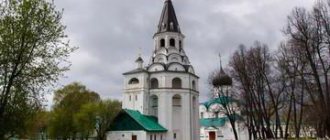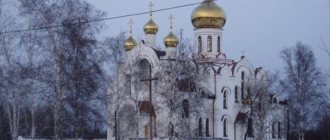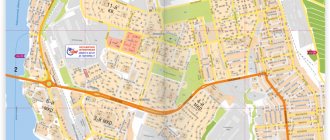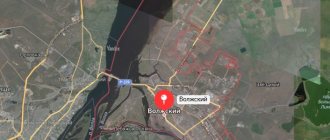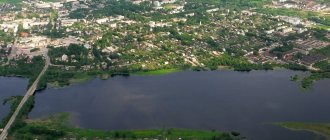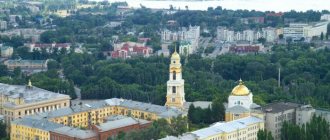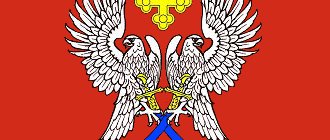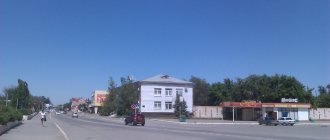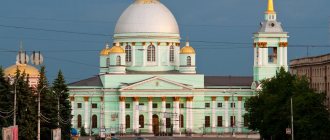The history of the city of Voronezh begins in the 16th century. By historical standards, the city is still a teenager, but has already seen a lot.
Voronezh witnessed the events of the Time of Troubles, the construction of the first Russian fleet and the battles of the Great Patriotic War. It was here that the TU-144 and IL-2 aircraft were designed and the production of the first domestic video recorders was launched.
Voronezh is the birthplace of the Oryol trotter and the place where mammoths once roamed. Here you can also find a monument to the kitten from Lizyukov Street from the cartoon of the same name and even take a swim in the “sea.”
Voronezh is very different: heroic, but a little provincial, strict, but at the same time sweet and cozy. Its wide green streets invite leisurely strolls. Photos of the city of Voronezh only partially convey its extraordinary atmosphere. This is not a metropolis with a frantic rhythm, but it is not a quiet provincial town either. Voronezh undoubtedly has a soul and a beating heart, which makes it so vibrant and attractive.
Let's take a deeper dive into the history of this amazing city and discover its innermost secrets, which it has silently kept for more than 400 years since its founding.
The city during the Second World War
The war did not bypass Voronezh. Hitler's army gathered its best units and on June 28, 1942, launched an attack on the city. For the Soviet command, the enemy's attack was unexpected. German troops rushed in two directions: to Voronezh from Kursk and to Ostrogozhsk from Volokolamsk. Only 5 tank divisions, 3 motorized and 2 infantry divisions were approaching the city. The same picture emerged in other directions. More than 30 German units were involved on this front.
The enemy broke into Voronezh on July 6, 1942 and occupied its western part. By the end of summer, the right bank of the city gradually came under enemy troops. The same fate was destined for Boguchar, Ostrogozhsk and Rossoshi, that is, the western regions of the Voronezh region were occupied.
The fighting on the Voronezh Front lasted 22 months—that’s 667 days. For 212 days, the territory of the city was divided into two parts: free and occupied. There was a fierce struggle for every block, street, and every house. No matter how hard the enemy tried, he failed to completely capture Voronezh. The city did not give up in the unequal struggle, survived, and then began to drive the enemy from its land.
During the period of hostilities the city suffered greatly. In place of most of the buildings, only ruins remained, and even those were mined. Almost 92% of all residential buildings were destroyed. The Nazis cut down parks and gardens. Almost nothing has been preserved from the former Voronezh.
Since the beginning of the war, Voronezh was periodically bombed, which briefly disrupted the tram service in the city. In 1942, the tram remained the only means of transport in Voronezh, since motor transport was mobilized to the front. It carried cargo and used it to transport the wounded from the station to hospitals. The tram system continued to operate until the right bank part of the city and the depot were captured by German troops.
The occupation did not pass without leaving a trace for the residents. The population of the city itself and villages in the Voronezh region suffered. During an air raid in June 1942, bombs hit the Pioneer Garden, where 300 children died. The Germans carried out mass executions of civilians. Thus, 450 people were shot in Peschany Log. The trees of the Pervomaisky Garden became gallows for 34 citizens. But the patriotism of Voronezh residents is invaluable. They were not broken by the enemy. There were no traitors among them - no one became a burgomaster, a German henchman.
"Khrushchev"
Photo — Roman Demyanenko
Mass construction start time
: second half of the 50s.
The active construction of low-rise economy-class houses, devoid of architectural delights on the facade, began in the USSR after the adoption of the decree “On the development of housing construction in the USSR” dated July 31, 1957. This document marked the beginning of new housing construction. The main goal of building “Khrushchev” buildings is to implement the motto “An apartment for every worker.” Frame houses according to standard designs were erected in record time. Low, maximum five floors, houses made of panels or bricks without an elevator or garbage chute. Amenities were sacrificed for the sake of economy.
– Khrushchev-era apartment buildings have small kitchens. My house, for example, is only 6 square meters. m. Although it must be said that in such apartments everything is small, starting with a narrow tiny corridor, in which it is difficult for two people to separate. Ceiling height is 2.5 meters. The hall is a walk-through room. In our “three rubles”, for example, from the corridor we enter the hall, and from it we can already go to the bedrooms. Combined bathroom. A funny feature of the “Khrushchev” apartments is a small window between the kitchen and the bathroom. It was designed to allow street light into the bathroom, but it was often used for other purposes. Such windows were a paradise for Soviet voyeurs if several families lived in the apartment at once,” said the owner of the Khrushchev apartment, Pyotr Sentsov.
Perpetuating memory (Main monuments related to the Second World War)
- A memorial sign to the troops who defended the city (“The enemy did not pass here in 1942-43!”).
- Chizhovsky bridgehead is a memorial complex in Voronezh, dedicated to Voronezh soldiers who defended the city during the Great Patriotic War.
- Mass grave and memorial in the central park of culture and recreation.
- Memorial complex "Sandy Log".
- Monument in the former Garden of Pioneers. More than 300 children were killed at this site by a German plane bomb.
- A military memorial in the village of Podgornoye, Kominternovsky district, was erected on the mass grave of 2,294 soldiers.
- War memorial in the Young People's Park.
- Monument to Soviet pilots who fought in the Voronezh sky.
- Monument-obelisk to soldiers who died in the Patriotic War of 1812, the First World War and the Great Patriotic War of 1941-1945.
Training of future specialists
There are a huge number of cities, remembering which certain associations immediately come to mind, for example: Sochi is a resort city, Moscow is an expensive metropolis. And Voronezh is, first of all, a city of students. Today, the city has over 35 higher educational institutions and more than 50 secondary specialized institutions, where about 127 thousand students study. Voronezh ranks third throughout Russia in terms of the number of foreign students - more than 1,400 people from Europe, Africa, and South America study at local universities.
Voronezh State University is the oldest educational institution in the Black Earth Region. It has a unique history and is rightfully considered the center of national culture and science. Since its opening, excellent specialists in various fields of activity have emerged from its walls: lawyers, journalists, economists, ecologists and pharmacists.
Another equally significant university in Russia is the Voronezh State Medical Academy named after Burdenko, which was founded in 1918. In the 21st century, it is considered a huge scientific, educational and medical complex, in which over 10 thousand students, doctors and cadets study and train. The structure of the academy includes 7 faculties, three research institutes, two own clinics, a scientific and medical library and even a museum complex.
Merits of the city in the military history of Russia
Voronezh has been known since the end of the 16th century as a stronghold of the Moscow state. The city, together with nearby settlements, was designed to protect Moscow from attacks by the Crimean Tatars.
The official year of foundation of Voronezh is considered to be 1586.
The most glorious milestone in the history of Voronezh is associated with the name of Peter I, who created the Admiralty in the city and began building Russia's first regular military fleet. Over 15 years, more than 200 ships were built in Voronezh, which allowed Russia to win a number of victories.
Modern Voronezh
After the collapse of the USSR, the economic situation in Russia changed greatly. Large industrial enterprises in Voronezh found themselves on the verge of bankruptcy. To overcome the economic crisis, most of them entered various concerns and holdings together with other enterprises. Great difficulties arose in the urban economy (poor condition of roads, unrealistic operation of electric transport, etc.), which by 2010 had already been practically overcome.
In 1990, Voronezh was included in the list of historical cities by the Ministry of Culture and the State Construction Committee of the Russian Federation. In the 90s, a huge number of churches were returned to the diocese; their restoration was started or continued. To this day, many temples are being built. In 2003, the city was elected the capital of the Day of Slavic Literature and Culture, and the first All-Russian festival of cellists was held. And in 2008, Voronezh was awarded the title “City of Military Glory.”
At the beginning of September 2011, the fifth in the world and the first in Russia Global Network Operations Center of Nokia Siemens Networks opened in the city. On these same days, Voronezh celebrates its 425th anniversary for five whole days. The authorities gave the anniversary the status of a federal-scale celebration, which, in turn, attracted considerable investment from the regional and federal budgets, spent on the improvement of the city.
The most significant military events associated with the city
“On the day the war began, the Voronezh region was declared under martial law. On November 7, 1941, a military parade took place, which was hosted by Marshal S.K. Tymoshenko. Due to the successful counter-offensive of Soviet troops near Moscow, the front line stabilized 120 km west of Voronezh.
The situation became sharply more complicated in June 1942, when enemy air raids on Voronezh intensified. The capture of Voronezh by Hoth's 4th Panzer Army was part of the summer offensive of the German Army Group South towards Stalingrad and the Caucasus under Operation Blau. From June 28 to July 3, 1942, having broken through the defenses at the junction of the 13th and 40th armies of the Bryansk Front, units of the 24th Tank Division and the mechanized division "Great Germany" reached the Don River and on July 4-5, 1942 created bridgeheads to the west and southwest of Voronezh. On July 6, tanks and motorized infantry of the 4th German Tank Army broke into the city and by the end of July 9 captured its right bank part. But already on July 10, the northeastern outskirts of Voronezh were recaptured from the enemy. During the defense of Voronezh in July 1942, its defenders (soldiers of the garrison, 3rd Air Defense Division, 232nd Rifle Division, 18th Tank Corps, individual artillery regiments and units of the 2nd Air Army) stopped the enemy, defended the left bank and 4- 5 days delayed the breakthrough of the German army group to Stalingrad, thwarting the plan to encircle the Southwestern Front in the Middle Don. On July 7, 1942, the Voronezh Front was created, whose troops participated in a number of defensive and offensive operations, including the defense and liberation of Voronezh. On July 12, the first private offensive of the Voronezh Front troops began. On July 14, the village was temporarily released. Podgornoye is the “northern gate” of Voronezh. Attacks by Soviet troops in August-September 1942 led to the creation and expansion of the Chizhov bridgehead on the right bank of the Voronezh River. In the battles for Voronezh, the armies and fronts were commanded by N.F. Vatutin, K.K. Rokossovsky, I.D. Chernyakhovsky, R.Ya. Malinovsky, F.I. Golikov, M.M. Popov, S.A. Krasovsky and other military leaders. In October–December 1942, local positional battles took place near Voronezh. In the Voronezh area, up to 10 divisions of the 2nd German Army were pinned down. On January 25, 1943, during the Voronezh-Kastornensky operation, troops of the 60th Army of General I.D. Chernyakhovsky was completely liberated from Voronezh.
For 212 days, the front line passed through Voronezh. The active defense of the city helped to survive and defeat Stalingrad, pinning down up to a third of the forces of Army Group B. The Battle of Voronezh marked the beginning of the disruption of the summer offensive of German troops in 1942. The civilian population from Voronezh was driven deep into the occupied territory. About 500 people were shot in Peschany Log on the southwestern outskirts of the city. The city was destroyed by more than 90%. During the war, more than 32 thousand people, natives of Voronezh, died. 13 natives of Voronezh became Heroes of the Soviet Union, 3 became full holders of the Order of Glory.
"Czechs"
Photo — Lyudmila Minaeva
Mass construction start time
: mid 70s
“Czech” apartments are usually called apartments that were designed according to the Czech standard. The houses are multi-storey, brick or panel. The apartments are quite spacious - about 40 m2 in a one-room apartment, more than 50 m2 in a two-room apartment. The fundamental difference between Czech apartments and Khrushchev and Brezhnevka apartments is the large area of the rooms and spacious kitchens - up to 10 m2. The layouts of Czech apartments are very diverse, but in general, perhaps The only difference is that such apartments always have a balcony or (more often) an extensive loggia. Other features include a separate bathroom; in some series there is access to the balcony through the protruding part of the adjacent room or from the corridor. The glazed windows occupy almost the entire wall and face one side of the house.
Merits of the city's rear
In the first year of the war, industry and agriculture in the Voronezh region worked intensively. The leading industries in 1941 were metallurgy, metalworking, and mechanical engineering. With the outbreak of the war, industry almost completely switched to fulfilling military orders: production and repair of military equipment, production of ammunition, weapons, army uniforms, and equipment. Since July 1941 at the plant named after. The Comintern produced more than three hundred BM-13 (Katyusha) rocket launchers at the plant named after. Lenin - components for them, the aviation plant produced more than a thousand Il-2 attack aircraft, and field radio stations were produced. In July 1941, the plant named after. Dzerzhinsky began repairing armored trains. With the approach of the front in September-October 1941, the evacuation of the most important enterprises to the eastern regions of the country began. Valuable equipment, tools, and raw materials were exported. Plant named after Dzerzhinsky in the fall of 1941 was evacuated to Krasnoyarsk, in October 1941 - to Novosibirsk, plant named after. Lenin in December 1941 - to Penza and the city of Kungur, Molotov (now Perm) region, plant named after. Comintern was evacuated to Sverdlovsk, plant named after. Kalinina - in the city of Chimkent, Kazakh SSR. By the end of 1941, 117 enterprises were evacuated from Voronezh. Tens of thousands of railway workers ensured the evacuation of industrial enterprises and the population, the transport of troops and cargo to Stalingrad, and often worked under conditions of bombing and artillery shelling.
At the beginning of 1942, after a successful counter-offensive of Soviet troops near Moscow, when the front line stabilized 120 km west of Voronezh, the State Defense Committee considered that the threat to Voronezh had passed and some enterprises were returned from evacuation. The factories named after them resumed work. Telman, named after. Dzerzhinsky, synthetic rubber named after. Kirov, "Electrosignal". At the end of June 1942, in connection with the rapid advance of Nazi troops towards Voronezh, a second evacuation hastily began; in such conditions, the equipment and raw materials of most enterprises could no longer be completely removed. Plant named after Dzerzhinsky was evacuated to the city of Chkalov (now Orenburg). On the left bank of the Voronezh and Don rivers there remained 102 industrial enterprises of union and republican subordination (mainly food), 273 regional industrial enterprises and industrial cooperation enterprises that worked for the needs of the front. Enterprises on the right bank of the river. Voronezh was almost completely destroyed. Damage to only one plant named after. Dzerzhinsky amounted to 130 million rubles.
House of Vyakhirevs
Photo — Roman Demyanenko
Where:
st. Plekhanovskaya, 16.
When built
: 1904
Style
: eclecticism.
At the beginning of the 20th century, a descendant of a famous merchant family, Arkady Vyakhirev, built a luxurious red brick mansion on Novomoskovskaya Street (after the revolution - Plekhanovskaya Street). On the ground floor he placed his store of shoes and other manufactured goods. His family lived on the second floor. Part of the upper floor was rented out for housing to townspeople.
– The construction boom of the late 19th – early 20th centuries is associated with the fashion to build apartment buildings. It was good business at the time. And the Vyakhirevs’ apartment building is a striking example,” said Olga Rudeva.
The house was built according to the design of Streltsov. In Soviet times, the Vyakhirevs’ house housed a grocery store, which Voronezh residents began to call the “red store” because of the color of the building. Now the old building houses shops, a pharmacy and office space.
Information from RIA Voronezh
In architecture, eclecticism is a mixture of baroque, renaissance and classicism, a denial of the canons of traditional styles in architecture. In eclecticism, materials that were new for that time were used: figured red brick, reinforced concrete, cast iron, large-sized glass. The history of eclecticism in architecture begins with a period when avant-garde artists, in search of the new and unusual, began to face the problem that everything had already been created and invented before them. As a result, a fashion arose for combining pre-existing items and adding something of one’s own. This is how the world learned about a new style - eclecticism.
Military units and formations formed from the city population
Throughout 1941, there was a planned mobilization of citizens of military age into the army. About 560 thousand people were called up from the Voronezh region, including about 47 thousand people from the city of Voronezh. At the same time, thousands of Voronezh residents joined the fighter battalions and tens of thousands joined the militia units, including the Voronezh Communist Volunteer Regiment, which joined the 1st Guards Rifle Division. Additional conscription into the army to replenish the Voronezh and Southwestern fronts was carried out in the summer of 1942 in the left bank (along the Don River) part of the region, and in the winter of 1943 in the liberated right bank areas of the region. The last military conscription of young men born in 1927 was carried out in the fall of 1944. In various defense works in 1941-1942. About 500 thousand people participated.
Industry
Interesting facts about the industry. The Voronezh Aviation Plant built the Tu-144 supersonic passenger aircraft, which in 1968 was the second to overcome the speed of sound. The first passenger aircraft to fly faster than sound was the American Douglas DC-8 turbojet airliner, but the speed was not gained in normal flight, but in a controlled dive. The maximum speed of the Tu-144 was twice the speed of sound, the aircraft could theoretically fly at a speed of almost 3,000 kilometers per hour, and could accommodate up to 100 passengers on board. The planes were taken out of service due to unprofitability, since the ticket, which was one and a half times higher than the cost of a ticket on a regular passenger plane, did not cover operating costs, and Soviet citizens could not pay more.
In October 1977, the first wide-body aircraft in the USSR, IL-86, was built in the city; this type of passenger airliner is called an Airbus.
The city produced the first video recorders in the Soviet Union - first on reels, then on cassettes. In the USSR, VCRs cost from 1,000 to 3,000 rubles; they were a real luxury (the average salary of an engineer was 200 rubles, a Zaporozhets car cost 2,500 rubles).
The city developed an engine for RD-0105 rockets; in 1959, it made it possible, for the first time in the world, to develop a second escape velocity (for the Earth it is 11.2 kilometers per second and allows one to overcome gravity and leave the Earth’s orbit). Developments in rocketry were used to create the RD-108 engine, which lifted the Vostok 1 rocket into the air; Yuri Gagarin flew into space on this rocket.
The Altai mobile communication system was developed at the Voronezh Scientific Research Institute of Communications. In Moscow, the Altai system began to be used in 1963, in Voronezh - in 1967.
Outstanding historical figures of Russia (natives of the city)
- Ivan Bunin is a Russian writer and poet.
- Ge Nikolai is a Russian painter, master of portraits, historical and religious paintings.
- Teresa Durova is a Soviet and Russian circus performer, trainer, People's Artist of the RSFSR.
- Koltsov Alexey Vasilievich is a Russian folk poet.
- Marshak Samuil - Soviet poet, playwright, translator, literary critic.
- Andrey Platonov is a Soviet writer and playwright, an original Soviet writer in style and language of the first half of the 20th century.
- Cherenkov Pavel - Soviet physicist.
- Feoktistov Konstantin Petrovich - pilot-cosmonaut of the USSR, Hero of the Soviet Union, Doctor of Technical Sciences, professor.
Business card of the city
Each city has its own unique appearance: famous buildings, monuments, parks, bridges or entire neighborhoods. And every city dweller has his own favorite places, where he spent his childhood, or had his first date, or spent his years of study. And every person, when naming a city, has an association: Paris - the Eiffel Tower, Moscow - the Kremlin, St. Petersburg - the Hermitage building or the Bronze Horseman. Anyone who has been to Voronezh will definitely remember the two-level bridge over the reservoir and the building of the main administration of the South Eastern Railway. No wonder this building is the calling card of the city. But not many people know the history of this beautiful building. The first design of the building was approved in 1928, its author was a young architect, a native of the city of Voronezh, N.V. Trinity. The most pompous building in the Stalinist Empire style - they now say it had the same name in the 1930s of the last century, however, it looked completely different.
During the war the building was destroyed. And in the post-war period, the same Troitsky creates a new project and revives his brainchild from the ruins. And since 1952, its seventy-meter tower has risen above the city. During the Khrushchev years, the tower was classified as an “architectural excess” and the author, along with others, was mentioned in a government decree. Nikolai Vladimirovich was ironic about this: now, at least, no one will be able to take credit for the authorship of this building.
First mentions
Although the remains of settlements dating back to the 8th-9th centuries are found on the territory of the modern city, the history of the city of Voronezh actually originates in the 12th century. We find the first message about the city in the Laurentian Chronicle for 1177. Nikonovskaya for the same period contains an even more detailed mention of the city:
Prince Yaropolk Rostislavich fled to Voronozh, and there he walked from city to city... And so he went to Voronozh, seized him, and led him to Volodymer
In total, Voronezh is described in ancient Russian chronicles no more than 3 times. Nevertheless, there is every reason to believe that the city of the same name was founded near the banks of the Don back in the days of Kievan Rus.
It is worth mentioning separately the name of the city of Voronezh, which could come from either the noun “raven” or the adjective “voronoi”. The water in the river could be black, that is, black, dark, on which the city of the same name was built.
And, finally, another version of the appearance of the name of the city is its origin from the ancient Slavic name Voroneg. Whether this mysterious man, after whom the ancient settlement was named, really existed, we will probably never know. Therefore, the name of the city will forever remain shrouded in an aura of mystery and mystery.
